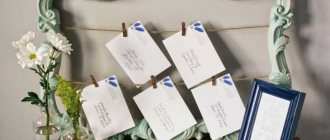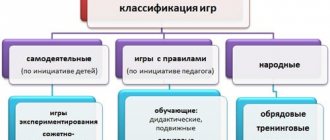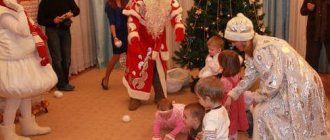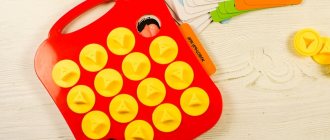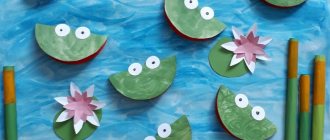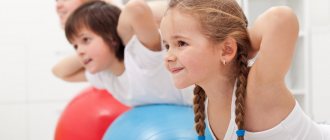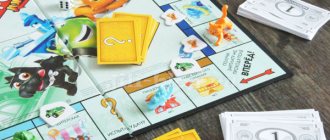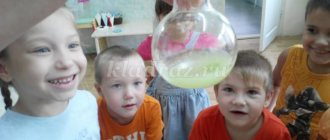Winter template for design.
Winter templates are designed to bring to life your countless thoughts related to preparing your group for the coming of winter, conducting classes, organizing winter activities and leisure activities in honor of winter and snow. We have prepared colorful frames that will help in the design:
- Shield “Winter” with a nature calendar, a page of statistics of temperature observations, poems, stories and signs of winter
- New Year's scenarios, invitation cards for holidays, quizzes, competitive events.
- Moving folders “New Year. Curious facts", "History of Santa Claus", "Santa Clauses of other countries", "New Year's riddles, ditties, songs, folk games."
- Homework for preschoolers with questions and riddles “Winter fun”, “Our winter walks”, “Let's help the birds”.
- Consultations “Parental misconceptions about frosty weather”, “Algorithm for putting on winter clothes”, “Safety of winter walks”.
A letter from Santa Claus and a letter of praise.
In the frosty season before the New Year holidays, just amuse every child with a magical letter. A letter from Santa Claus, like a letter of praise, can be simply and quickly issued directly on our website, 100% free of charge. For design, use the editor below.
Give your friends and employees a “Letter from Santa Claus”:
To change the text, click on the text in the image above. By clicking on one of the four pictures on the right, you can change the letter template. In the 2nd and 4th templates you can upload your photo (photo of a child). The 3rd and 4th templates are certificates of commendation. Clicking the “Save” button will download the print-ready file to your computer. “Print” – prints the form.
To work (edit, download) you need Adobe Flash Player installed (free). If you don't see a huge image above the previous paragraph, then you don't have Flash Player installed.
Painter: Alena Garbuz.
Below on the page are the texts of letters approved by Santa Claus. Copy your favorite message, message, message and paste it into the editor in the image above.
Text of the letter from Father Frost and the Snow Maiden “Magic Ball”
Grandfather Frost is writing for you from the North Pole. The Snow Maiden helps me: she finds the addresses of good children on the magic crystal globe. Now your house is sparkling with silver, the magic ball has shown you to us, Alice. My granddaughter Snegurochka and I looked at you and didn’t recognize you. How you have grown a year, become smarter, more serious! You help your loved ones, every day you learn something new. Therefore, I, Grandfather Frost, with my own magical power, open the doors to you into the world of discoveries and adventures that await you in the New Year! We wish you joy, health and happiness! In the New Year, your dream will certainly come true!
Your friends Father Frost and Snow Maiden.
Layout of children at tables during meals
Publications on the topic:
Work experience “Development of speech in children of senior preschool age through the use of mnemonics” Dear colleagues, I would like to present to your attention my work experience. I would like to begin my speech with the words of a famous teacher:
Using the technique of joint drawing as a special method of teaching autistic children Joint drawing is a special gaming method. During joint drawing, the teacher draws an object or plot drawing that is close to the experience.
Abstract of the educational activity for children with mental retardation “Memorizing the poem by A. S. Pushkin “Winter” using modeling techniques” State budgetary preschool educational institution kindergarten No. 79 of a combined type in the Primorsky district of St. Petersburg.
Consultation for educators “Formation of a culture of behavior in preschoolers during meals” Nutrition culture in kindergarten Nutrition culture in kindergarten is a science necessary in modern life. Fast food that looks attractive.
Consultation “How to behave at the table so that the child always has an appetite and positive emotions during meals” How to behave at the table so that the child always has an appetite and positive emotions during meals. • Do not make comments at the table;.
Consultation “Organizing children’s nutrition and developing aesthetic eating skills. Culture of behavior at the table” Children’s health cannot be ensured without rational nutrition, which is a necessary condition for their harmonious physical growth.
OOD in mathematics “Independence of number from the spatial arrangement of objects. Mathematical riddle" OOD in mathematics on the topic: Independence of number from the spatial arrangement of objects. Mathematical riddle. Relationships between numbers.
Open lesson in the senior group “Use of the MMC technique when introducing children to objects of inanimate nature” Type of OD: Educational Direction: cognitive development Integration of educational areas: cognitive, social and communicative development.
Parent meeting “Etiquette during meals” I would like to start my speech with the folk truth: what you teach a child to do, that’s what you will get from him. Voluntary or involuntary mistakes of parents.
Scheme for constructing individual support for children with developmental disabilities in preschool educational institutions Individual support is a system of interconnected goals, time, tasks, coordinated actions of all preschool specialists directed.
Text of congratulations from Santa Claus “Magic Letter”
I, Grandfather Frost, hasten to congratulate you on the New Year. On New Year's Eve, various dreams and desires come true. Do you know why? Since all people become kinder, they give each other gifts and make pleasant surprises. And Snegurochka and I help them with this.
Alice, my magic book told me that in the New Year you will have many new victories, and you will become even smarter, stronger, more attractive. Remember, my letter is also magical. When you read it, your dreams will fall into our magic piggy bank, and in a year they will certainly come true! Dream, be happy and don’t be bored!
Alice, I wish you a funny way to celebrate the New Year, to amuse mom and dad with your own grin. Happy New Year!
Documentation of a group teacher in kindergarten
(consultation for teachers)
Senior teacher: E.N. Redichkina
Due to the fact that state standards have been introduced into the educational process, for kindergartens this is the Federal State Educational Standard for Preschool Education, maintaining documentation of a preschool teacher in accordance with the Federal State Educational Standard for Preschool Education is a necessary stage of work.
According to the Federal State Educational Standard for Preschool Education, the teacher must maintain and document:
Local acts are a folder with instructions: official, occupational safety, health and life protection of children, modeled on your preschool institution. It is done once and updated periodically. Shelf life is permanent.
The list of basic documentation for the educator includes local acts to ensure the activities of the educator:
1.1. Job description of a teacher.
- 2. Instructions for protecting the life and health of children.
1.3. Labor protection instructions.
- Documentation on the organization of the teacher’s work:
2.1. The work program, which was drawn up as part of the implementation of the Federal State Educational Standard for Education by age group for 1 academic year. It reflects the main directions of educational work with children of a certain age. Take, for example, the work program “From birth to school” as a basis and, based on the general program, you need to create such a document for your group.
2.2. Planning educational activities.
2.2. Planning educational activities.
Comprehensive thematic planning. It is built on a thematic principle and allows the teacher not only to systematically solve assigned tasks and easily introduce regional and ethnocultural components, but also, depending on the characteristics of his preschool institution, at his own discretion, partially or completely change topics or topic names. Complex thematic plans are plans for working with children by season and week of each month, where general areas of work are recorded. That is, what do you want to achieve each month. Calendar plan for educational work. To specify and adjust the educational work provided for by the comprehensive thematic plan, the teacher uses a calendar plan in his work. For ease of use of the plan, the teacher divides it into two parts: the first and second half of the day. To write a plan, it is recommended, in addition to a comprehensive thematic plan, to use a cyclogram of the group’s educational activities (it is not mandatory, but very convenient and helps the teacher correctly plan his work with children during the day.)
In the first half of the day, the teacher plans conversations, individual and joint activities, reading fiction, morning, finger, articulation gymnastics, didactic games, instilling cultural and hygienic skills, and a walk.
In the afternoon - invigorating gymnastics, conversations, individual work, experimentation, role-playing and didactic games, a walk, work with parents.
The calendar plan for educational activities is a specific, detailed plan for each day. It must be consistent with the work program and comprehensive thematic plan. Here we write down everything that we will do with the children during the day: exercise, activities, games, walks, routine moments, work with parents, etc.
2.3. Model of organizing educational activities (network of classes).
The lesson grid simplifies the planning of educational activities and is a table by day of the week in which we enter all classes, including music and physical education. It helps the teacher systematize work with children during the current month. According to the requirement of SanPin 2.4.1.3049-13 “Sanitary and epidemiological requirements for the design, content and organization of the operating mode of preschool educational organizations” on the maximum permissible volume of educational activities, the load in the first half of the day in the junior and middle groups should not exceed 30-40 minutes, in senior and preparatory - 45 minutes and 1.5 hours, respectively. In the middle of the time allotted for continuous educational activities, a physical education session is held. Breaks between periods of continuous and educational activities are at least 10 minutes.
2.4 . Evaluation of the results of mastering the Pedagogical Diagnostics program. Each teacher constantly studies his students while working. Such work is carried out during observations of the activity of children in spontaneous and specially organized activities. For this purpose, the documentation of the kindergarten teacher includes observation cards of child development, which make it possible to record the individual dynamics and development prospects of each child in the course of various types of activities (speech, cognitive, artistic, play, project and physical development).
During educational activities, teachers must create diagnostic situations in order to assess the individual dynamics of children and adjust their actions.
2.5. Teacher's portfolio.
In a modern preschool institution, teachers have to work in conditions of constant competition. In most cases, a kindergarten teacher’s portfolio is a folder that is created and updated by a preschool teacher in order to improve their qualifications, for which proof of work activity is required. We can also say that a teacher’s portfolio is a kind of form for teacher certification, with which you can present materials from your work, courses attended, and successes achieved. The teacher’s portfolio is located in the group or in the methodological office of the preschool educational institution. Shelf life is permanent.
2.6. Creative folder for self-education (Shelf life - permanent). Any profession requires self-improvement, and even more so work related to children. One of the ways to improve the professional skills of teachers is self-education. This is the purposeful work of the teacher to expand and deepen his theoretical knowledge, improve existing and acquire new professional skills and abilities in the light of modern requirements of pedagogical and psychological sciences. During the academic year or other period of time, the teacher must study in depth a problem, the solution of which causes him certain difficulties or which is the subject of his special interest. Timely completion of this document also helps in collecting materials for teacher certification. Select a topic and gradually fill the folder with materials
- Documentation on organizing work with preschool children.
3.1. Attendance sheet . It is necessary in order, firstly, to record the number of children in the group daily. This helps ensure that children are fed and parental fees are paid. Secondly, it is easier for the teacher to focus on conducting classes and distributing material for each child. Thirdly, it helps to track the incidence of children in certain periods, outline the nurse’s work aimed at improving their health, and during the adaptation period, identify unreasonable omissions that complicate the child’s successful adaptation to the conditions of the preschool educational institution.
3.2. Individual information about parents and pupils . Documentation of a preschool teacher in accordance with the Federal State Educational Standard for Preschool Education necessarily involves identifying information not only about children, but also about parents. In officially accepted practice, a special journal usually contains the following information about children attending the group: - last name, first name of the child; - Date of Birth; — residential address and telephone numbers; — Full names of parents, grandparents; — parents’ place of work and telephone numbers; - social status of the family (number of children in the family, living conditions, complete - not complete family). The teacher should, in a tactful conversation, find out information from the parents and reflect it in the journal. Moreover, the received data cannot be disclosed; this information must be confidential. Now parents are also required to provide written consent to the processing of personal data. The information obtained helps the teacher neutralize the possible negative impact of the family environment on the child, if any. And you can understand the child better if you know more about his living conditions and the status of his parents.
3.3 . Age list of children. The composition of children in the same group is heterogeneous in age, and sometimes the difference can reach up to a year. The teacher must take into account the age of each child in the group, since the difference in age affects the characteristics of the individual approach to each of the children. A simple age list can help prevent some very serious problems in the group.
3.4. Health sheet for group pupils. In practice, it is important to develop a differentiated approach to children, taking into account their health status. For this purpose, groups have so-called “Health Sheets”, which are filled out by medical personnel. After all, as a rule, children do not attend preschool educational institutions due to illness. Medical staff and educators must work closely with each other. Without this relationship, competent health work is impossible. The doctor distributes children into health groups. Based on the results of medical examinations (conducted 2 times a year in kindergarten groups and 4 times a year in early age groups), depending on the nature and severity of deviations in the children’s health, the doctor gives recommendations, documenting them. In the practical work of a teacher, it is the recommendations that are important, and not the clinical diagnosis (it is a medical secret). All of the above is reflected in the “Health Sheet” for each child
3.5. Journal of hardening activities The journal of hardening activities helps to purposefully carry out health-improving activities with children while respecting the individual characteristics of the child.
3.6. Seating scheme for children at tables. As you know, for the formation of correct posture and the prevention of visual impairment, the correct seating of children at the table is of no small importance, for which a set of furniture (the height of the table and chair) is selected for each child. The height and weight of children are determined 2 times a year, respectively, a set of furniture should be determined 2 times a year. For this, we need a scheme for seating children at tables, which is adjusted as necessary depending on changes in the physical condition of the children in the group.
3.7. Group daily routine. A daily routine for warm and cold periods of time is necessary for a rational duration and reasonable alternation of various types of activities and rest for children during the day.
3.8. Children's stool map and morning filter (only for children under 3 years old). A children's stool map and morning filter allows you to identify a child's illness at an early stage and take measures to preserve the health of the children's group. The morning filter in other age groups is carried out and filled only during the epidemiological period.
3.9. Adaptation sheet. For the period of adaptation of children, another type of document is introduced - an adaptation sheet. It notes the date of admission of the child, his time spent in the preschool educational institution, and behavioral characteristics in a symbolic manner. Timely analysis of this document helps teachers identify and eliminate or smooth out the child’s adaptation problem. Based on the analysis, the joint work of “teacher - physician - psychologist - parents” is coordinated.
3.10. Register of reception and care of children signed by parents. The daily morning reception of children should be carried out by educators who interview parents about the state of health of the children, examine the pharynx, skin, if indicated, measure body temperature. In nursery groups, admission takes place with daily measurement of body temperature. During an influenza epidemic, body temperature is measured daily in all age groups. Children identified during the examination with suspected illness are not admitted to the kindergarten, and those who are ill are isolated from healthy children in the isolation ward during the day until their parents arrive.
- Documentation on organizing interaction with families of pupils.
4.1. Interaction with parents of group students. The content of work with parents is planned for a month or a week. It should be indicated on what days and what will be done by each teacher of the group, and what general garden events will be held. Moreover, it is necessary to write not only those events that are carried out by the teacher, but also by the specialists working in this group. Regardless of who conducts the classes, the organizer will in any case be the teacher. The work can be scheduled in various forms: - parent meetings, - consultations (individual, group, - workshops, - thematic exhibitions, - occasional conversations with parents, - interest clubs, - joint holidays, - entertainment and leisure, - questionnaires, - parent gatherings, - trainings - excursions, - hiking trips, - parental participation in the social life of the group, etc. How many events to plan, everyone determines for themselves. Work in kindergarten with parents should be planned in accordance with the annual goals of the institution.
The program recommends:
- stock,
— master classes
— trainings —
- evenings of music and poetry,
— visits by families to family subscription program events organized by cultural and art institutions, at the request of the kindergarten;
- family living rooms,
- festivals,
- family clubs,
— question and answer evenings,
- salons, studios,
- holidays (including family ones, - walks, excursions, - project activities, - family theater.
4.2. Minutes of parent group meetings . The minutes of parent meetings in kindergarten are an important document. Its preparation must be approached responsibly and competently. Any decision becomes valid only if there is a protocol. It must always be carried out, regardless of the degree of importance of the issues being discussed. The protocol notebook is started during the formation of the group and is maintained until graduation from kindergarten. It is numbered page by page, filed, sealed with the seal of the kindergarten and the signature of the head.
Protocol drawing up plan:
— Full name of the institution
— Date of the meeting at the preschool educational institution
— List of those present (teachers, administration, parents)
— Topic of the meeting (agenda)
— List of speakers (educators, medical worker, speech therapist, educational psychologist, heads of clubs, studios, parents, etc.)
- Solutions
— Signature of the secretary, teacher, and chairman of the parent committee.
All protocols are kept by the teacher.
All this documentation can be divided into mandatory and recommended. But what is mandatory and what is not is decided not by the teacher, but by the authorities. For competent planning and documentation, you need to firmly know the subject of the documentation: the work program of your kindergarten, on the basis of which almost all other documents are based.
The following documentation is required:
— Calendar plan of educational activities for the group;
— Teacher’s work program for his group;
- Children's attendance sheet. Recommended documentation that may or may not be kept:
— Information and regulatory folder: local acts, job descriptions, safety regulations, health regulations, etc.;
— Planning and analysis folder: information about the children, about the parents, a plan for hardening and other routine moments, a schedule of classes, a scheme for seating the children at the table, adaptation sheets, a log of children’s reception, etc.;
— Methodological support for the educational process: a comprehensive thematic work plan, a list of programs, technologies, author’s developments, materials for pedagogical diagnostics, a teacher’s portfolio, materials for self-education, work with parents and everything you have.
Theoretically, you may not keep some of the recommended papers, but experience shows that it is better that you have as many documents as possible, since verification will not listen to your excuses that you did not know that this is not necessary.
If you are not a fan of long texts, you can switch to cards. This is not prohibited and very convenient. A file of work with parents, a grid of activities, work plans can be drawn up in the form of separate sheets of cardboard with written activities.
An example of comprehensive thematic planning according to the Federal State Educational Standard for Education.
List of basic teacher documentation
1. Local acts to ensure the activities of the teacher: (storage period - permanent)
1.1. Job description of a teacher.
1.2. Instructions for protecting the life and health of children.
1.3. Labor protection instructions.
2. Documentation on the organization of the teacher’s work:
2.1. Basic general education program of preschool education by age groups.
2.2 Scheduling
2.3. GCD schedule.
2.4. Monitoring of children’s achievement of the planned results of mastering general education (pedagogical diagnostics, monitoring of integrative qualities) (Shelf life: 5 years).
2.5. Equipping a subject-development environment in accordance with the age group.
2.6. Teacher's portfolio (located in the group or in the methodological office of the preschool educational institution. Storage period is permanent).
2.7. Creative folder for self-education (Shelf life - permanent).
2.8. Group passport
3. Documentation on organizing work with preschool children.
3.1. Children's attendance sheet (the attendance sheet is laced, numbered, and sealed).
3.2. Group daily routine for warm and cold periods of time.
3.3. Morning filter (only for children under 3 years old) and during the epidemiological period in all groups.
- Documentation on organizing interaction with parents and families of students.
4.3 Minutes of parent group meetings.
(Source - Internet resource)
New Year's greeting “Crystal Ice”
Happy New Year! At the moment, when you read my letter, I look into a huge crystal piece of ice and see your reflection. This piece of ice is magical - it grows when you laugh. You are happy, and I see your grin.
I know that new fun activities await you in the New Year. Don't miss them. Rejoice every day! Remember my message in the morning, and you will see how many exciting things you will do. A grin works wonders, I know that for sure!
Maxim, I ask you, help me too - prepare surprises for your loved ones and best friends. Let their crystal ice grow too! Look for the gift under the Christmas tree.
With best wishes, your Santa Claus!
Congratulatory letter “Grow up smart”
Hello, dear Olechka!
I, Grandfather Frost, congratulate you on the New Year holiday! I've been following you for a whole year and I want to say that I like you. You are active, don’t sit idle, love loud games and adventures. Activity is great! Just try to use it correctly - learn more and learn to do everything yourself. After all, even the squirrels in my forest do not jump on the branches idle, but get food for themselves.
I’ll tell you a secret - you won’t be bored in the new year. You will have friends, gifts, and surprises. Grow up smart! And I will continue to watch your successes and rejoice at how beautiful and well-mannered you are.
Correct design of tables in kindergarten
To decorate a group room in preschool institutions, it is worth using furniture with letter markings that comply with GOST and Federal State Standards.
Among the materials, it is necessary to prefer different types of materials:
lumber, laminated plywood, chipboard or fiberboard. More popular options: pine, larch, beech, spruce and fir.
The working surface of training tables should remain smooth and matte, which helps reduce visual fatigue during training.
The rules for seating at tables in kindergarten provide for the use of the following types of models:
- Four-seater table for children from 1 to 5 years old with dimensions 70x70;
- Double tables for preschoolers aged 5-7 years with an adjustable tabletop tilt, drawers for storing teaching aids;
- Double trapezoidal additional table for children 1-4 years old;
- Single table for domestic use.
When organizing lighting on the left side, study tables are placed against a light-carrying wall. Double tables should be installed in approximately three rows, four-seater tables should be installed in two rows.
Standard ergonomic calculations prove that the space between tables in a kindergarten should be about 5 meters.
This arrangement of tables in a kindergarten allows you to easily move the chair away, get up from the table and sit back without any extra effort, and also provide the teacher with free access to each of the children.
